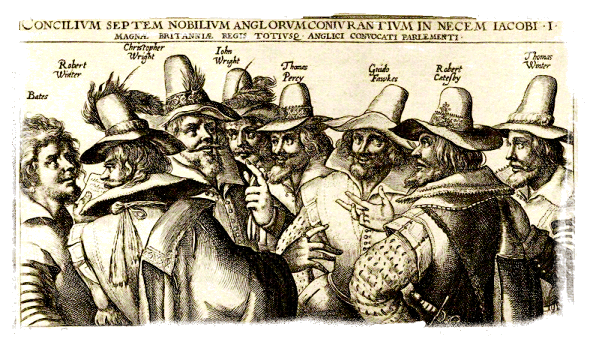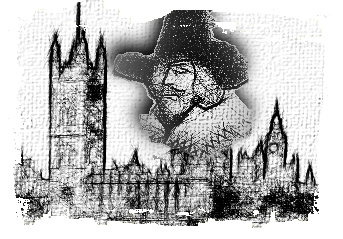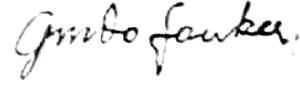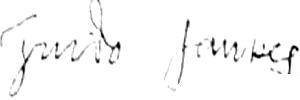It looks like you're using an Ad Blocker.
Please white-list or disable AboveTopSecret.com in your ad-blocking tool.
Thank you.
Some features of ATS will be disabled while you continue to use an ad-blocker.
15
share:

Remember, remember the Fifth of November,
The Gunpowder Treason and Plot,
I know of no reason
Why the Gunpowder Treason
Should ever be forgot.
Guy Fawkes, Guy Fawkes, t'was his intent
To blow up the King and Parliament.
Three-score barrels of powder below
To prove old England's overthrow;
By God's mercy he was catched
With a dark lantern and burning match.
Holla boys, Holla boys, let the bells ring.
Holloa boys, holloa boys, God save the King!
And what should we do with him?
Burn him!
The 5th of November, although not a British public holiday, has been celebrated in the United Kingdom for over four hundred years. Usually we gather together for a private (or public) event where the focal point is an evening’s fireworks display and the burning of a “guy” (an effigy) on a bonfire. This is usually accompanied by the consumption of hot foods such as soup, baked potatoes, burgers and sausages.
But what are we Brits actually celebrating and why?
I’ll be honest, I haven’t studied the Gunpowder plot since I was in infant school and all I really remember is that it was a foiled plot to blow up Parliament. Guy Fawkes was the bloke arrested, caught red-handed and sentence to death. In fact somewhere in between I was never really sure if we were celebrating the daring plot or the fact that it was foiled.
The story itself involves a plan to murder the King by men loyal to their Catholic faith and the nagging doubt that the state itself may have actually have been behind the events.
The seeds of the conspiracy began back with Henry VIII. The monarch seized control of the Church from Rome in the 1530s. His heir, Elizabeth I, oversaw a period when Catholics were marginalized, fined for not attending Anglican Church services (recusancy), imprisoned and even executed for practising their faith. The Protestant Church dominated and the Spanish Armada of 1588 and deepened the suspicions of Catholics.
In 1603 Elizabeth I passed away to be succeeded by James I. It was hoped by many that he would be more tolerant to Catholics. At first it seemed he would be. His wife Queen Anne was a Catholic and he immediately ended the recusancy fines. However this gave Catholics a higher visibility across England and a number of plots against the monarchy came to light.
On February 4th 1604 denounced the Catholic Church and re-introduced fines for recusancy after the Pope sent a rosary to his wife Queen Anne. Gradual suppression of Catholics continued with even a Parliamentary Bill threatening to outlaw the Catholic faith in England.
The Gunpowder Plot

Although his name is not associated with the celebrations today , Robert Catesby, was the mastermind who hatched what has become known as the Gunpowder plot. Catesby studied at Oxford but did not take his degree to avoid swearing the Oath of Supremacy (an allegiance to the monarch and Church of England) due to his loyalty to the Roman Catholic Church. He fought in the Essex rebellion of 1601 against the crown but was spared his life by the Queen. Catesby was a charismatic character and assembled a number of other Catholics, Guido (Guy) Fawkes, Thomas Winter, John Wright and Thomas Percy. A group he believed would help him restore a Catholic to the English crown in a treasonous plan. The numbers of which grew as the plans began to take shape.
The main objective of the plot was to kill King James. The King’s opening of Parliament would provide the ideal opportunity plus the bonus of a number of other ‘targets’ would be present on the day. As fears over the spread of the plague gripped the nation, the state opening of Parliament was delayed a number of times until November 5th 1605.
The official account of the times includes the story that the conspirators had been digging a tunnel under the Houses of Parliament. However this is in some doubt as no physical evidence of this has ever been found. However as luck had it they were able to rent a cellar underneath the House of Lords in March 1605. Over time the men smuggled 36 barrels of gunpowder into the cellar. Enough explosive power to blast everything in the vicinity into the sky.
By late October 1605 the plan was in its final stages. Guy Fawkes, having previous experience with explosives, was to light the fuse and then escape to Europe where he would drum up support for their acceptance amongst sympathetic nations. Digby would lead a Catholic uprising in the Midlands and capture Princess Elizabeth, the King’s daughter, installing her as a puppet monarch.
There was some concern amongst the conspirators and their close circle for the safety of some of the noblemen who would be at the opening of Parliament. Discussion and disagreement about whether to issue a warning to various people took place. Then on October 26th an anonymous letter was received at the home of Lord Monteagle who asked one of his servants to read it aloud.
“My lord out of the love I bear to some of you’re frends I have a care of your preseruasion therefore I would advise you as you tender your life to devise some excuse to shift of your attendance at this parliament for god and man hath concurred to punish the wickedness of this time and think not slightly of this advertisement but retire youre self into youre control where you may expect the event in saftey for though there be no appearance of any stir yet I say they shall receive a terrible blow this parliament and yet they shall not see who hurts them this councel is not to be condemned because it may do you good and can do you no harm for the danger is passed as soon as you have burnt the letter and I hope god will give you the grace to make good use of it to whose holy protection I commend you.”
This was then taken by Monteagle to Whitehall and handed to then Lord Salisbury (Robert Cecil) who was trusted with matters of state security by the King. Salisbury chose to bide his time and wait, believing striking at the last minute to be the most effective way to deal with the matter. Although the conspirators were made aware of the letter they chose to visit London and sensing no serious danger to their plans continued with their plan to murder the King and most of England’s dignitaries.
An initial search of Westminster on November 4th was conducted where a large pile of firewood was found in the under-croft beneath the House of Lords, along with Fawkes, who told them that the firewood belonged to his master, Thomas Percy. The name Percy aroused suspicion and the King ordered a more thorough search later in the evening.
The King’s search party once again discovered Fawkes in the cellar dressed in hat, cloak and boots surrounded by the gunpowder barrels hidden under piles of coal.
The plot was foiled.
 The conspirators were found guilty and sentenced to horrific executions. The
government responded by introducing tough new anti-Catholic legislation and it would be 200 years before these laws were finally relaxed.
The conspirators were found guilty and sentenced to horrific executions. The
government responded by introducing tough new anti-Catholic legislation and it would be 200 years before these laws were finally relaxed. continues below>>>
edit on 2/11/13 by mirageman because: tidy up
State Conspiracy?
 Some believed that Lord Salisbury , James I’s right hand man was behind the plot
or at the very least became aware of it at an early stage but let it develop. It is known he wanted to ensure the King did not go soft on Catholics
due to his extreme views. He wanted Catholicism driven out of England.
Some believed that Lord Salisbury , James I’s right hand man was behind the plot
or at the very least became aware of it at an early stage but let it develop. It is known he wanted to ensure the King did not go soft on Catholics
due to his extreme views. He wanted Catholicism driven out of England.
Some believe he instigated the whole plot through Thomas Percy and craftily manipulated the events leading up to the moment Fawkes ,the patsy, was caught. Percy was then implicated in the plot and killed to complete the cover-up.
We could also ask how did these men obtain such large amounts of gunpowder, when the government tightly controlled explosives. There was enough to bring down everything within a half mile radius of Westminster?
In times of high religious tension and a major concern why were a group of Catholics allowed to rent a cellar right underneath the Houses of Parliament?
Although a warning letter was issued how did this lead to the unprecedented searching underneath the Houses of Parliament and our man Fawkes getting found out in the 11th hour?
Does any of this sound vaguely familiar?
Something to think about as your bonfire burns….
 Some believed that Lord Salisbury , James I’s right hand man was behind the plot
or at the very least became aware of it at an early stage but let it develop. It is known he wanted to ensure the King did not go soft on Catholics
due to his extreme views. He wanted Catholicism driven out of England.
Some believed that Lord Salisbury , James I’s right hand man was behind the plot
or at the very least became aware of it at an early stage but let it develop. It is known he wanted to ensure the King did not go soft on Catholics
due to his extreme views. He wanted Catholicism driven out of England. Some believe he instigated the whole plot through Thomas Percy and craftily manipulated the events leading up to the moment Fawkes ,the patsy, was caught. Percy was then implicated in the plot and killed to complete the cover-up.
We could also ask how did these men obtain such large amounts of gunpowder, when the government tightly controlled explosives. There was enough to bring down everything within a half mile radius of Westminster?
In times of high religious tension and a major concern why were a group of Catholics allowed to rent a cellar right underneath the Houses of Parliament?
Although a warning letter was issued how did this lead to the unprecedented searching underneath the Houses of Parliament and our man Fawkes getting found out in the 11th hour?
Does any of this sound vaguely familiar?
Something to think about as your bonfire burns….
reply to post by mirageman
Very nice history post. Publicity for the date outside of England would likely not be happening if it wasn't for that movie. Loved the movie by the way (well, maybe love Ms. Portman), and from it has emerged a lasting meme in the form of the mask.
Very nice history post. Publicity for the date outside of England would likely not be happening if it wasn't for that movie. Loved the movie by the way (well, maybe love Ms. Portman), and from it has emerged a lasting meme in the form of the mask.
edit on 2-11-2013 by Aleister because: (no
reason given)
Remember, remember, the 11th of September
The thermite treason and plot
I know of no reason the thermite treason
should ever be forgot...
Looks like they turned the tables on us. How's that for some bitter irony?
The thermite treason and plot
I know of no reason the thermite treason
should ever be forgot...
Looks like they turned the tables on us. How's that for some bitter irony?
edit on 2-11-2013 by AfterInfinity because: (no reason
given)
Very good post concerning a true conspiracy. I did once hear it suggested that it was King James himself who deduced the method of the attempt from
the contents of the warning letter that was sent. Its a novel and intriguing thought that the Gunpowder Plot might have been a very early example of
a false flag, but since it was used by the controlling powers of the time to erode civil liberties through fear, why not.
edit on 2-11-2013 by
hotel1 because: (no reason given)
reply to post by mirageman
Brilliant overview. Thanks. It's motivating me to invite a few neighbours in to watch the film again. Not much I know, but I'm thinking planting seeds...
S&F& : up :
Brilliant overview. Thanks. It's motivating me to invite a few neighbours in to watch the film again. Not much I know, but I'm thinking planting seeds...
S&F& : up :
reply to post by Aleister
Yes Guy Fawkes day is very British thing and due to the continuing safety campaigns is slowly getting marginalised by Halloween which as we all know occurs less than a week before. I guess it's easier to promote Halloween, sell pumpkins and scary masks as opposed to fireworks and lighting bonfires. Not that I have anything against 'All Hallows Eve' as it's a bit of scary fun especially for the kids.
Yes the famous movie and it's memes have probably done more to promote the significance of the 5th November beyond these isles than 400 years of us all lighting bonfires and launching fireworks.
However I am embarrassed to say that until I looked it all up I didn't know much at all about the details of what is a true conspiracy. And I love history.
Yes Guy Fawkes day is very British thing and due to the continuing safety campaigns is slowly getting marginalised by Halloween which as we all know occurs less than a week before. I guess it's easier to promote Halloween, sell pumpkins and scary masks as opposed to fireworks and lighting bonfires. Not that I have anything against 'All Hallows Eve' as it's a bit of scary fun especially for the kids.
Yes the famous movie and it's memes have probably done more to promote the significance of the 5th November beyond these isles than 400 years of us all lighting bonfires and launching fireworks.
However I am embarrassed to say that until I looked it all up I didn't know much at all about the details of what is a true conspiracy. And I love history.
hotel1
Very good post concerning a true conspiracy. I did once hear it suggested that it was King James himself who deduced the method of the attempt from the contents of the warning letter that was sent. Its a novel and intriguing thought that the Gunpowder Plot might have been a very early example of a false flag, but since it was used by the controlling powers of the time to erode civil liberties through fear, why not.edit on 2-11-2013 by hotel1 because: (no reason given)
In some write ups the King is said to have been convinced there was clue in the letter to Monteagle containing the phrase "...terrible blow.." and he believed a bomb or explosion was going to go off in Parliament. The King was no stranger to assassination attempts and assaults. These were turbulent times. Others believe Lord Salisbury wanted it all to seem that the King worked out the details of the plot to ensure a hardline was taken with Catholicism.
Interesting stuff.
reply to post by mirageman
You've certainly done a great job of presenting the history, some points of view, and the theories regarding the events known as Guy Fawkes day. I don't know enough about the day beyond the movie, never studied it. So your comments are at least presented without the movie coming between people and the data. Nice research and presentation of those points of view. I'd like to read other points of view on this important event in the history of the time. Now if only you can explain the acting talents of Nathalie Portman, who did the well-appeciated journeyman work on many films, including V, before winning her Academy Award. Nice work on her part, that's for sure.
I am partial to Halloween myself, and used to know people who kept the Halloween decorations on their porch up all year.
You've certainly done a great job of presenting the history, some points of view, and the theories regarding the events known as Guy Fawkes day. I don't know enough about the day beyond the movie, never studied it. So your comments are at least presented without the movie coming between people and the data. Nice research and presentation of those points of view. I'd like to read other points of view on this important event in the history of the time. Now if only you can explain the acting talents of Nathalie Portman, who did the well-appeciated journeyman work on many films, including V, before winning her Academy Award. Nice work on her part, that's for sure.
I am partial to Halloween myself, and used to know people who kept the Halloween decorations on their porch up all year.
edit on 2-11-2013 by Aleister because: (no reason given)
edit on 2-11-2013 by Aleister because: (no reason
given)
edit on 2-11-2013 by Aleister because: (no reason given)
reply to post by Aleister
LOL! For some reason I always confuse Natalie Portman with our own Kiera Knightley. Well maybe a certain other "Phantom "movie is responsible for that.
Who I am sure you'll agree is equally talented.
I really need to read more myself on this fascinating plot. Unfortunately there are only so many hours free in a day.
Oh and we tend to have people here in the UK who leave their Christmas decorations up all year. Some of them are fat bearded blokes with a ruddy complexion but beyond that I don't really see a connection as to why.
LOL! For some reason I always confuse Natalie Portman with our own Kiera Knightley. Well maybe a certain other "Phantom "movie is responsible for that.
Who I am sure you'll agree is equally talented.
I really need to read more myself on this fascinating plot. Unfortunately there are only so many hours free in a day.
Oh and we tend to have people here in the UK who leave their Christmas decorations up all year. Some of them are fat bearded blokes with a ruddy complexion but beyond that I don't really see a connection as to why.
reply to post by mirageman
How can I ever forget? It is my Birthday. Interestingly enough, my family has it's name all over the event.
How can I ever forget? It is my Birthday. Interestingly enough, my family has it's name all over the event.
AfterInfinity
Remember, remember, the 11th of September
The thermite treason and plot
I know of no reason the thermite treason
should ever be forgot...
Looks like they turned the tables on us. How's that for some bitter irony?.....
There are a lot of unresolved issues from that dreadful day.
However forgive my ignorance but I never quite understood why anyone would hijack and fly two jet airliners into the World Trade Center after lining the place with thermite just so it all collapsed perfectly. Why not just blow the WTC to bits with the explosives and crash the airliners into the Whitehouse or somewhere else for maximum impact?
I guess that conversation is probably not for this thread though.
And just to pull this back on topic.
Guy Fawkes was arrested and questioned (the King had authorised a series of escalating tortures for the conspirators). He was an experienced military man and at first refused to go into detail.
On the 5th after capture his signature looked like this.

By the 7th of November when the King's permission for torture had been authorised his signature was showing signs of the physical and mental degeneration.

A day later Fawkes was a broken man either that or his pencil was

Fawkes was sentenced to death on 31st Jan 1606. He was to be hung, drawn and quartered. This was quite a brutal punishment were individuals would be hung to the point of asphyxiation and then torn apart whilst still conscious. Fawkes managed to jump and break his own neck and avoided the final brutal death cast upon him by his judges.
Some think we have gone soft on criminals in the centuries that have passed.
Guy Fawkes was arrested and questioned (the King had authorised a series of escalating tortures for the conspirators). He was an experienced military man and at first refused to go into detail.
On the 5th after capture his signature looked like this.

By the 7th of November when the King's permission for torture had been authorised his signature was showing signs of the physical and mental degeneration.

A day later Fawkes was a broken man either that or his pencil was

Fawkes was sentenced to death on 31st Jan 1606. He was to be hung, drawn and quartered. This was quite a brutal punishment were individuals would be hung to the point of asphyxiation and then torn apart whilst still conscious. Fawkes managed to jump and break his own neck and avoided the final brutal death cast upon him by his judges.
Some think we have gone soft on criminals in the centuries that have passed.
reply to post by mirageman
Great job on the post - S&F!
I knew some of the history, but being on the wrong side of the pond the known details of the event generally provided here were sketchy at best. Hell, if it wasn't for the movie "V", I doubt most people here would know anything about Guy Fawkes at all.
And speaking of being on the wrong side of pond, your thread title "5/11..." is parsed a little differently here too. So for us Yanks:
11/5 - Gunpowder, Treason & Plot
Great job on the post - S&F!
I knew some of the history, but being on the wrong side of the pond the known details of the event generally provided here were sketchy at best. Hell, if it wasn't for the movie "V", I doubt most people here would know anything about Guy Fawkes at all.
And speaking of being on the wrong side of pond, your thread title "5/11..." is parsed a little differently here too. So for us Yanks:
11/5 - Gunpowder, Treason & Plot
I believe it was illegal NOT to celebrate Bonfire Night in Britain right uptil 1959.
Interesting theme on reversals/opposites here between the Gunpowder Plot and 9/11.
First, there is the difference in dates from UK to U.S, 5/11 and 11/5.
So, their 5/11 is our 9/11 (yes I am American but I am only using words like their and our for ease of typing on a smartphone, although typing this explanation seems to have surpassed the effort it would have taken to just type UK's 5/11 is America's 9/11. If people were not so goddamn whiney about everything I could have just typed what I felt like and just not needed to worry about somebody accusing me of not being "worldly" enough, as is the general charge against Americans)
Also, it does noy take much imagination to see that an upside down 5 looks like a 9... All you really have to do is finish the near circle at the bottom of the 5.
The Gunpowder Plot failed, although it may have been planned that way. On 9-11 "terrorists amazingly overcame all of our security protocols" and the "plot" "succeeded". Some believe it may have been planned that way. The opposite theme is still there in that one failed, the other succeeded.
Both may have been government false flags used in order to condemn a religious group. First Catholics, then Muslims.
I guess gunpowder was a fairly high tech thing back then, just like nanothermite today.
The gunpowder plot had an explosion planned in the cellar, the bottom of the building and actually underground. On 9/11 planes struck the upper floors of skyscrapers, way up.there...the opposite of underground.
Maybe there are more similarities or reversals in the details.
First, there is the difference in dates from UK to U.S, 5/11 and 11/5.
So, their 5/11 is our 9/11 (yes I am American but I am only using words like their and our for ease of typing on a smartphone, although typing this explanation seems to have surpassed the effort it would have taken to just type UK's 5/11 is America's 9/11. If people were not so goddamn whiney about everything I could have just typed what I felt like and just not needed to worry about somebody accusing me of not being "worldly" enough, as is the general charge against Americans)
Also, it does noy take much imagination to see that an upside down 5 looks like a 9... All you really have to do is finish the near circle at the bottom of the 5.
The Gunpowder Plot failed, although it may have been planned that way. On 9-11 "terrorists amazingly overcame all of our security protocols" and the "plot" "succeeded". Some believe it may have been planned that way. The opposite theme is still there in that one failed, the other succeeded.
Both may have been government false flags used in order to condemn a religious group. First Catholics, then Muslims.
I guess gunpowder was a fairly high tech thing back then, just like nanothermite today.
The gunpowder plot had an explosion planned in the cellar, the bottom of the building and actually underground. On 9/11 planes struck the upper floors of skyscrapers, way up.there...the opposite of underground.
Maybe there are more similarities or reversals in the details.
new topics
-
Paradox of Progress
Ancient & Lost Civilizations: 4 hours ago -
Joe Biden gives the USA's Highest Civilian Honor Award to Hillary Clinton and George Soros.
US Political Madness: 7 hours ago -
Winter Storm
Fragile Earth: 7 hours ago -
Biden Face Planted Somewhere
Politicians & People: 9 hours ago -
A great artist and storyteller, for kids of all ages
General Entertainment: 10 hours ago
top topics
-
Joe Biden gives the USA's Highest Civilian Honor Award to Hillary Clinton and George Soros.
US Political Madness: 7 hours ago, 13 flags -
What Is 'Quad Demic'? Mask Mandate Returns In These US States
Diseases and Pandemics: 13 hours ago, 11 flags -
Volcano Watch 2025
Fragile Earth: 16 hours ago, 8 flags -
The Future of fashion .
Social Issues and Civil Unrest: 14 hours ago, 8 flags -
Winter Storm
Fragile Earth: 7 hours ago, 7 flags -
Bin Cyber Junk…
Short Stories: 15 hours ago, 6 flags -
Biden Face Planted Somewhere
Politicians & People: 9 hours ago, 5 flags -
A great artist and storyteller, for kids of all ages
General Entertainment: 10 hours ago, 5 flags -
Paradox of Progress
Ancient & Lost Civilizations: 4 hours ago, 5 flags -
The Undertones - Teenage Kicks
Music: 15 hours ago, 3 flags
active topics
-
Post A Funny (T&C Friendly) Pic Part IV: The LOL awakens!
General Chit Chat • 7988 • : KrustyKrab -
Winter Storm
Fragile Earth • 18 • : RickyD -
What Is 'Quad Demic'? Mask Mandate Returns In These US States
Diseases and Pandemics • 29 • : TheRickestRick -
Paradox of Progress
Ancient & Lost Civilizations • 3 • : BingoMcGoof -
Here we again... CHINA having mass outbreak of something
Diseases and Pandemics • 24 • : NoCorruptionAllowed -
A great artist and storyteller, for kids of all ages
General Entertainment • 1 • : angelchemuel -
-@TH3WH17ERABB17- -Q- ---TIME TO SHOW THE WORLD--- -Part- --44--
Dissecting Disinformation • 3931 • : RelSciHistItSufi -
Joe Biden gives the USA's Highest Civilian Honor Award to Hillary Clinton and George Soros.
US Political Madness • 29 • : caterpillage -
NJ Drones tied to Tesla explosion at Trump Las vegas
General Conspiracies • 45 • : glen200376 -
New Jersey-Teachers Can Now Be Certified Without Passing Basic Reading Writing Math Testing
Education and Media • 14 • : boatguy12
15
